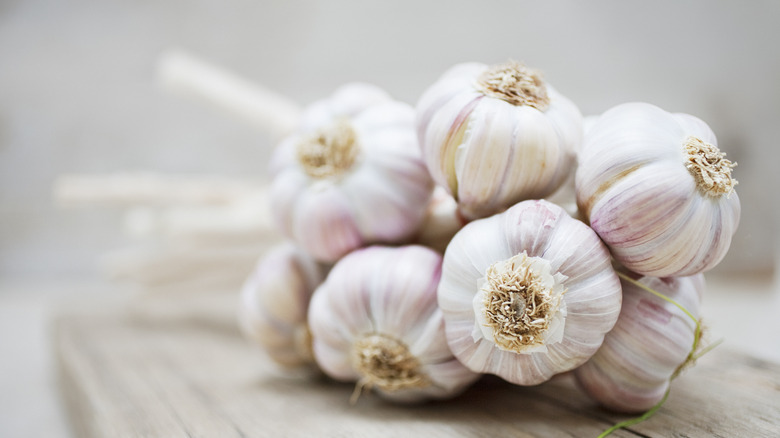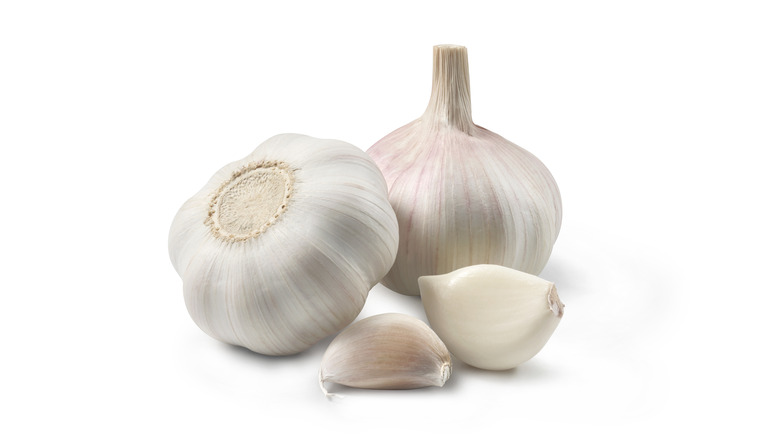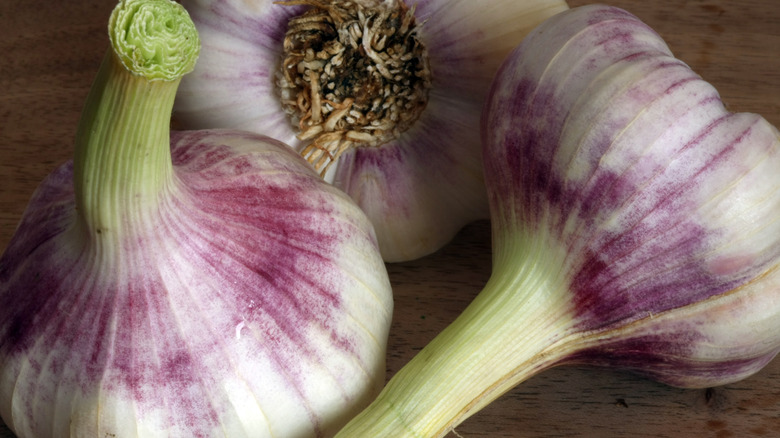What's The Difference Between American And Chinese Garlic?
Few ingredients are more globally universal than garlic. It's a major part of cuisines across the globe, a flavor which really can't be replicated with any other ingredient (and even if people make a lot of mistakes with it). But when something is this versatile, it makes sense that you're going to have different varieties from different locations, each with its own strengths and weaknesses. And when it comes to garlic you're likely to find in the grocery store, there are two main categories: Chinese garlic and American garlic.
But what actually is the difference between the two? There are actually a whole bunch of differences, some of which are readily apparent, some of which require a little bit more investigation. And while these are often not universal (there's overlap between the two in some cases), one of the surest ways to tell if you're looking at Chinese or American garlic has to do with the roots. Does the garlic still have them? Then it's definitely not Chinese (but not necessarily American, either).
The primary way to tell American from Chinese garlic is the roots
China actually produces more garlic than any other nation on Earth; roughly 75-80% of all garlic production comes from China. This is a stark increase from three decades ago when China only produced around 2% of the world's supply. As of 2009, roughly 50% of the garlic found in the U.S. came from China — and the number has surely increased since then. This has led to some U.S. politicians claiming Chinese garlic is a public health concern, including wild, unsubstantiated claims that Chinese garlic is grown in human feces.
Most American garlic, meanwhile, comes from the West Coast, particularly California. The town of Gilroy even considers itself the "garlic capital of the world" for its extensive production.
In truth, while there are differences between Chinese and American garlic, there's no hard data to back up the idea that Chinese garlic is somehow more dangerous or unsanitary. A lot of this speculation is simple xenophobia, on par with the persistent myths about MSG. In fact, one of the easiest ways to (potentially) tell Chinese garlic from American garlic has to do with import requirements specifically designed to keep it safe for consumption: Chinese garlic will always have its roots scooped off the bottom. This is required by U.S. law to ensure there's no contaminated soil clinging to the garlic itself (and it saves garlic producers on shipping costs due to reduced weight).
There are other ways to tell the two apart
It's important to note, however, that garlic with roots scooped off isn't necessarily Chinese; there's no U.S. regulation requiring garlic producers to leave the roots on, and some do remove it. If you see garlic with the roots still on, though, it's definitely American.
There are other ways to tell American garlic from Chinese garlic, too. Chinese garlic is almost always white, so if you see outer garlic skin that's purple, it's likely American (although again, plenty of American garlic is also white). Size matters here, too: Chinese garlic is pretty uniformly medium-sized, while American garlic ranges from small to large. So if you see particularly big or small garlic, you're dealing with an American variety. There are potential flavor differences, but these are subtle; blind taste tests have indicated that American garlic is more flavorful, but there's no scientific study to back this up.
Whichever variety you use, though, you shouldn't be afraid of your garlic source. There's no reason to be worried about contaminated Chinese garlic, so you can enjoy your pasta sauce in peace.


